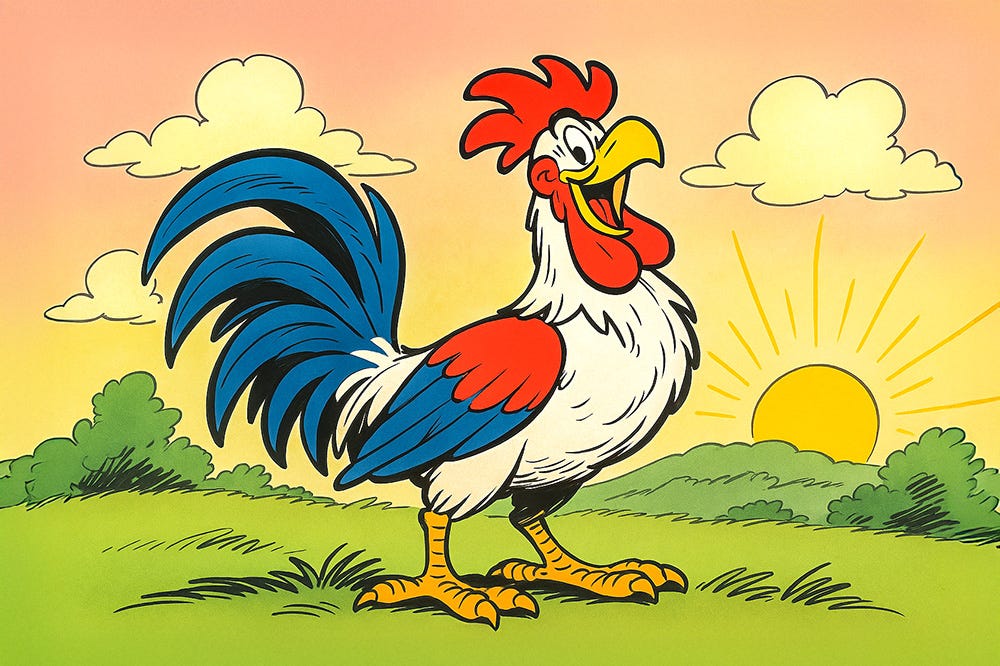The Gallic Rooster: France’s Proud, Crowing Symbol
A bird, a pun, a nation — how an animal that sings with its feet in the mud became the unofficial soul of the French Republic.
Bonjour!
This is the fourth instalment in my Substack series on France’s national symbols, leading up to Bastille Day.
Each week, we peel back the layers of history, myth, and meaning behind a familiar emblem. Last week, we explored Marianne. This time, we follow the feathers.
To read the full story of this fascinating emblem of France, consider joining us as a paid member. Merci beaucoup!
The Gallic Rooster
It all starts with a pun.
Yes, truly.
The reason the French chose a rooster — of all animals — to represent themselves is because in Latin, Gallus means both “Gaul” (the ancient name for France) and “rooster.” That’s it. That’s the joke. That was enough.
A linguistic coincidence became a national metaphor.
And not just any metaphor — one that has survived revolutions, monarchies, empires, defeats, jokes, ridicule, wartime posters, postage stamps, sporting triumphs, and more than a few French comedians. Most national symbols are born from law or legend. France’s? From a wordplay that stuck.
Yet the Gallic rooster has crowed louder and longer than most. Its silhouette is still visible across the country — perched on church steeples, embossed on coins, carved into war memorials, cast in bronze on the gates of the Élysée Palace.
But why?
Why this bird?
Why does he strut, proud and chest forward, on the banners of French rugby players and the weather vanes of sleepy villages alike?
What does it say about France — and about the French — that their national animal is not a lion, eagle or bear... but a rooster?
Let’s follow his trail — from antiquity to the pitch, from royal seals to peasant rooftops. 🐓
A crest from the past: from Gaul to gallus
We can’t talk about the rooster without going back to the Gauls, the ancient Celtic tribes who lived in what is now France before the Romans arrived.
These weren’t gentle farmers. They were fierce warriors — rebellious, tattooed, and fond of moustaches and oak trees. The Roman Empire had a hard time subduing them. Julius Caesar’s Commentarii de Bello Gallico was essentially a propaganda piece to justify his violent conquest.
So when the Romans started calling them Galli and noticed that gallus also meant rooster, a stereotype was born — at first as a mockery.
Roman coins and satire would sometimes depict Gauls with rooster crests, not unlike a modern political cartoon. But, as history often goes, what begins as ridicule can be reappropriated.
By the Middle Ages, the French themselves began to play along.
And as Christianity spread, the rooster acquired a second, much more serious meaning.
A symbol of light, of faith, of vigilance
In the New Testament, Jesus predicts Peter’s denial:
“Before the rooster crows, you will disown me three times.”
(Matthew 26:34)
This passage became central to the rooster’s medieval symbolism.
The crowing rooster was not only a reminder of Peter’s failure, but of Christ’s forgiveness. More broadly, it came to symbolise vigilance — a call to wake, to watch, to remain alert to one’s conscience and to the return of light.
That’s why Pope Nicholas I issued a decree in the 9th century: every church in Christendom was to place a rooster-shaped weather vane atop its bell tower. The cock would watch over the village — both literally and spiritually.
This is why even today, you’ll see thousands of rooster weathervanes across France, especially in rural regions like Alsace or Burgundy. They’re not just rustic ornaments — they’re vestiges of faith, of repentance, of light breaking through.
And they predate Marianne, the Tricolour, and even La Marseillaise by centuries.
Keep reading with a 7-day free trial
Subscribe to French Moments Newsletter to keep reading this post and get 7 days of free access to the full post archives.






